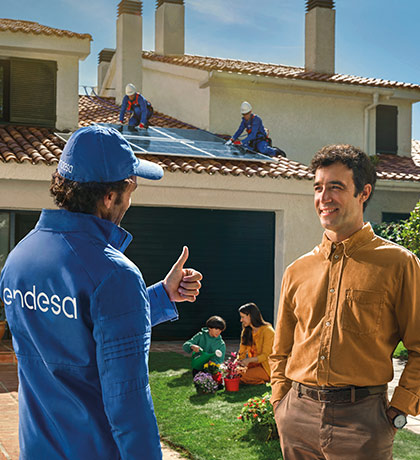If you prefer to always view the website in English, please click here.
Controlling electrical energy changed the course of civilisation. Among many other discoveries, the lightning rod represents a fundamental milestone. Benjamin Franklin’s idea allowed attracting lightning bolts to points that were not dangerous. Humanity stopped being afraid of storms.
People are often confused and associate the lightning rod with Edison, the inventor of the light bulb. In reality, this medal must be hung around the neck of the politician and scientist, Benjamin Franklin, one of the first people to propose daylight saving's time as a measure to save energy.
Franklin’s passion for researching electricity led him to pay attention to a phenomenon that had gone unnoticed by many others before him. One day, he was flying a kite when it was struck by lightning that burned it up, which led the ingenious researcher to wonder if it were possible to attract lightning bolts in some way.
He tied a metal key to his kites and continued flying them on stormy days until on 15 June 1752, he was able to capture another bolt. Electricity went down the string of the kite until reaching the key. That is how he demonstrated that it was possible to attract lightning bolts to metal structures, thus sparing other elements from being struck.
One year later, in 1753, they started to install the first lightning rods. Metal bars of between five and ten meters of length with a copper or platinum tip (materials with high electrical conductivity). Their progressive installation on roofs in the United States (and later in the rest of the world) has helped save countless lives and has prevented fires.
Once the lightning bolt is trapped, the metal bar continued in the form of the conduction line. This line was made with metal bars or copper wires. In any case, their function is to bring electricity to the ground. A dissipater, which is nothing more than an extension of this line, was placed underground. There, the electricity of the lightning bolt is diluted and absorbed without harming anyone.
The evolution of the original lightning bolt: Nikola Tesla
It has rained (and thundered) a lot since Franklin had his great idea. Yet almost 300 years later, there are many lightning rods around the world that continue being used exactly how he designed them. A metal bar with a copper tip, the conduction line also has copper and an underground dissipater.
However, this scheme underwent important revisions. In 1918, Nikola Tesla, discoverer of alternate current, notably perfected the invention. He realised that the tip of the lightning rod ionised the air and for that reason, attracted the lightning. However, at the same time, it converted the circulating air into a conductor, which could cause uncontrollable damages. That is how the lightning rod with a collection point and ample base was founded, which was much safer than the original.
Later, the combination of new materials and new technologies added more sophistication to the lightning rod, especially in two directions:
- Deionising lightning rods with electrostatic charge: which are intended to eliminate electrical fields in the structures, thus preventing lightning from forming on them. Today, most experts consider that they have not proven its efficacy.
- Lightning rods with a discharge device: they measure the electrostatic charges of clouds to predict when a lightning bolt will be produced. When they detect it, they launch an electromagnetic pulse upward that serves to capture the bolt from a distance. In this way, the possible damages from the bolt are reduced by falling toward the lightning rods.
Interesting facts and anecdotes about lightning bolts and lightning rods
- Cranes are not lightning-proof: the principle of the lightning rod is based on combining the negative electrical charge of a storm with the positive electrical charge of the earth. The lightning bolt is attracted by metal conductors. This also applies to metal structures, like cranes, which become an enormous lightning collector.
- The Eiffel Tower was designed as a giant lightning rod: in reality, it was designed as a laboratory for all types of scientific research, though especially to test theories about electricity and meteorology. This lightning rod over 325 meters tall receives an average of 5 lightning strikes per year. In 1902, for the first time, photographer M.G. Loppé immortalised the moment in which the storm became the emblem of Paris.
“The lightning rod was invented by Benjamin Franklin, but perfected decisively by Nikola Tesla.”
Take a minute to find the product that best suits you:
{{firstStep.title}}
Take a minute to find the product that best suits you:
{{title}}
{{content.phone.title}}
{{content.phone.text}}
{{content.phone.phoneText}}
{{content.form.title}}
{{content.form.text}}
{{content.form.success.title}}
You don't need to adapt to Endesa's tariffs because they adapt to you. If you go to our catalogue you can compare the different tariffs for yourself. Or if you prefer, you can answer a few questions and we will take care of comparing all the different electricity and gas tariffs and then make a customised recommendation.
Take a minute to find the product that best suits you:
{{title}}
{{content.phone.title}}
{{content.phone.text}}
{{content.phone.phoneText}}
{{content.form.title}}
{{content.form.text}}
{{content.form.success.title}}
You don't need to adapt to Endesa's tariffs because they adapt to you. If you go to our catalogue you can compare the different tariffs for yourself. Or if you prefer, you can answer a few questions and we will take care of comparing all the different electricity and gas tariffs and then make a customised recommendation.
Comparison of Electricity and Gas Tariffs
You don't need to adapt to Endesa's tariffs because they adapt to you. If you go to our catalogue you can compare the different tariffs for yourself. Or if you prefer, you can answer a few questions and we will take care of comparing all the different electricity and gas tariffs and then make a customised recommendation.
Spend a minute to find the product which best adapts to you:
{{firstStep.title}}
Spend a minute to find the product which best adapts to you:
{{title}}
Spend a minute to find the product which best adapts to you:



